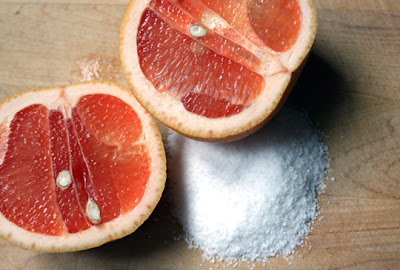Clean your tub with grapefruit and salt. Or not.

Those loopy youngsters at Apartment Therapy are for all time touting exertions-intensive and in all likelihood ineffective "inexperienced" alternatives to family cleaning supplies. The concept seems to be that in case you're inconvenienced, you then're come what may saving the earth.
I am a large proponent of sustainable practices and stewarding resources sensibly and equitably. With that said, scrubbing out your tub with a half a grapefruit and a few salt is absurd.
The piece in Apartment Therapy went on to break the process down into four easy to follow steps . I have a better idea. Here are my four steps. At the end of my steps you'll have a clean shower and full tummy.
1. Peel and eat grapefruit, ideally an Indian River purple.
2. Sprinkle salt on some clean, crusty bread. Top with excessive best olive oil and be transported.
Three. Spray down shower with SC Johnson's Scrubbing Bubbles.
Four. Come back ten minutes later and rinse.

Done.
Many household cleaners are a gimmick, they are marketing messages in a bottle. Developed to exploit your fears and perceived inadequacies, they represent an absolute waste of resources in the sense that they waste your money and your time.
Similarly, just because it came off a tree doesn't mean something's benign.
If you read that there was 1-Dimethoxy-2, 5-trimethyl-4-hexene, Acetic acid and decyl ester in something you were about to slosh around your bathroom would you be concerned? Well, they are but four of the thousands of chemicals in a grapefruit . They're probably harmless (I say probably because no one really studies them) but why are they inherently better than Disodium Ethanoldiglycinate, Butoxydiglycol, Ethoxylated Alcohol, Quaterinary Ammonium Chlorides? Those are the four ingredients that make Scrubbing Bubbles so gosh darn effective.
Chemicals that come from a lab and chemicals that come from a tree aren't inherently good or bad. In chemistry it's all about dose and duration. Most synthetic chemicals are engineered specifically to break down into their component parts and to do so quickly. What's in them is controlled tightly and studied thoroughly. I don't know that they're safer, but at least they're known.
Whether or no longer you use them is totally as much as you. There are a few matters I may not use because they waste resources. Usually my money, frequently my time and a number of times I don't use things due to the fact they waste the earth's resources or they may have an effect I don't want them to have. I say there's a stability you need to strike and the quality manner to strike that stability is to arm your self with knowledge and to make selections based totally on purpose and no longer emotion.
To that end, SC Johnson has a new website called What's Inside . What's Inside is a product-by-product list and explanation of what's in their products. It's enough to make me buy more SC Johnson products if only to demonstrate how much I applaud their move.
This strikes a chord in my memory of a conversation I had with considered one of my friends the opposite day. He's looking for a pesticide to kill off the caterpillars which might be consuming his tomato flora. He's concerned approximately what he's going to spray and rightly so. However, he desires some thing "natural" due to the fact he thinks it will likely be more secure. I reminded him that rattlesnake venom is natural however I doubt I'd consume a tomato that had been handled with it.